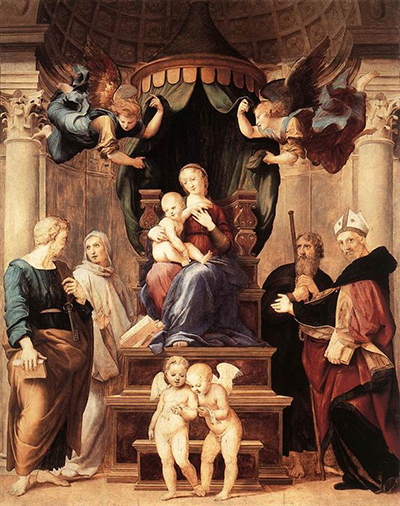The painting, Madonna of the Baldacchino by Raphael, was painted for a church of Santa Maria Assunta, during the mid-16th century. The story behind it is rather interesting.
The painting was commissioned by Cardinal Baldassare Turini, a native of Persia. The bishop wanted Raphael to paint the picture for the church of Santa Maria Assunta, which was in his hometown. The painting became the pride of the church later on in 1507. It was accepted gladly in the church immediately it was completed.
In 1697, the eldest son of Grand Duke Cosimo the III, Prince Fernando de Medici, visited Persia. He was astonished by the marvellous art-work and inquired the local clergy if he could keep the masterpiece. The Prince was in love with art. Fernando offered a total 1,000 Scudi and also commissioned the artist Pietro Dandini to paint a similar copy; almost identical to the original. After completion, the two arts were switched on 7th September 1697 during the night and in the discrepancy. The local clergy was very resourceful. He used the money to install a new church organ and extend the town's library.
Oils are employed on this painting. Artists universally accepted this technique in the mid-15th century. It was flexible and allowed a variety of painting techniques including blending and shading. The advantages of the techniques used are that they can be investigated to review the art processes of art used by Raphael during his painting. The painting style used demonstrates the artist's technical ability. It was painted for social contemplation, and many people admired it.
The structure is partially based on the Venetians' traditions and from Fra Bartolomeo. This can be noted in the monumentality and great compositions of the Giovanni Bellini. The Venetian aspects of the painting can be noted as the apse of the church which recalls the larger compositions of Giovanni Bellini. The saints are set in a semi-circular arrangement around the virgin and excited angles flying and opening the curtain of the baldachin. This gives the painting a feeling of free circulation. However, the personas are posed uniquely. This brings about the natural touch in the great descriptive composition of the painting.
After Raphael left Florence to Rome, the art was left unfinished. It is evident that the painting was completed by a third party in a year around 1697. The original art is currently stored in Palazzo Pitti in Florence. However, there are similar paintings all over the country. For instance, there is a painting in the Cathedral of Persia and also in the Pitti Palace.




